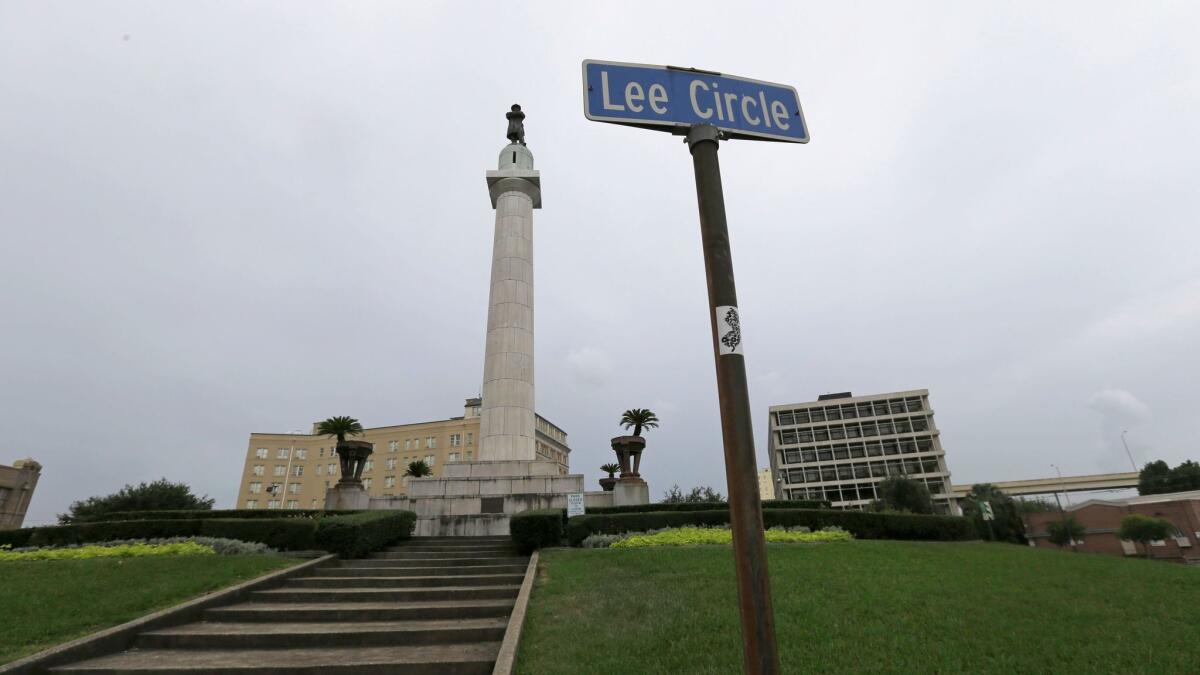Op-Ed: Confederate monuments give the finger to New Orleans

Last year my high school students and I took a Hidden History tour of New Orleans’ French Quarter with historian Leon A. Waters. He showed us overlooked, unmarked sites of African American and civil rights history among the neighborhood’s T-shirt shops and famed cast-iron balconies. The second-to-last stop was the Liberty Monument, an obelisk stashed away between the garage of an upscale shopping mall and a floodwall of the Mississippi River.
As my students read the plaque, they were visibly shaken: It honored the Reconstruction-era paramilitary White League’s attack on local government, killing more than 100 people, including several black police officers. They were even more shocked to learn that some residents were still fighting to preserve it.
Over the years, the white supremacist monument had been relocated and its wording modified, but it was still standing until last week, when it was finally removed — the first of four Confederate monuments that the New Orleans City Council voted to take down. Because of death threats received by contractors, and the volatile nature of the public debate, it was dismantled in the dead of night by masked workers in flack jackets, snipers at the ready. The other monuments depict Confederate President Jefferson Davis, Gen. Robert E. Lee, and Gen. P.G.T. Beauregard, and unlike the Liberty Monument, all are positioned on prominent thoroughfares.
It looks as though the removals might continue to take place under cover of darkness by masked and armed men. Which feels altogether wrong.
One persistent argument for preserving such monuments is that they are part of the landscape we grew up in, our history, our memories — and thus part of who we are. As a white New Orleanian who spent an unquestioning childhood seeing movies at the Robert E. Lee Theater and riding the Jefferson Davis Parkway, I might once have agreed. But just one afternoon of walking the French Quarter with someone who has a radically different relationship to our built environment helped me understand the depth of pain these memorials have inflicted on fellow New Orleanians.
New Orleans was already more than 150 years old when a minority of moneyed white men seeking to rehabilitate the image of the defeated Confederates installed these monuments against the best interests of much of the citizenry. They are ideological symbols meant to assert power over our public spaces, a fact that became palpable during a contentious City Council debate on the removal plan. When a gray-haired preservationist in a bow tie stood up and gave the finger to removal advocates, I understood that those statues, just part of our landscape, high up on plinths and columns, have been giving the finger to the majority of New Orleanians for generations. Giving the finger to the people who create our vibrant culture and drive our economy, to our celebratory and joyful customs, to the true heart of a diverse, if sometimes fractious port city. To our past and our future.
The legacy of slavery is very much still a part of our city’s landscape: poverty, the persistent segregation of our public schools, pay inequity, lack of affordable housing, our high incarceration rates. I was hoping to take my children to see the Lee monument removed, alongside other New Orleanians, so we could share a rare and badly needed moment of civic reckoning. Share one of the most important moments of a generation: a public, ceremonial dismantling of these monuments to racism, in broad daylight.
Instead, because of security concerns, fear and politics, it looks as though the removals might continue to take place under cover of darkness by masked and armed men. Which feels altogether wrong. As the city’s tricentennial approaches next year, we have the opportunity to choose which values to honor, create the landscape that will shape future generations, replace divisive symbols of revisionist history with more inclusive landmarks truer to the city’s spirit and its past. While the mayor has shown surprise at how the “community has torn itself apart” over the issue, there’s been little transparency from city government, and so far we have only vague public plans for what replaces the monuments, no clear process for healing.
The final stop on Waters’ tour was another monument some are calling to remove: U.S. Justice Edward Douglass White in bronze, tent-like robes. A former Confederate and member of the White League, which was responsible for black voter suppression and countless black deaths, he voted with the majority on the U.S. Supreme Court against local civil rights pioneer Homer A. Plessy in the landmark “separate but equal” decision.
This fall, Homer A. Plessy Community School, an open-access public school whose racial make-up reflects the city, is moving to the French Quarter. My son is a student there, and I’m eager for his class to take Waters’ tour, be inspired by the bravery, accomplishments and struggles they encounter on it. My hope is that their generation will grow up with a more honest and informed relationship to the city’s history than I had, will help move the city into a better future. I wonder what their thoughts will be when they arrive at White’s statue, just blocks from their school.
Anne Gisleson is the author of “The Futilitarians,” forthcoming from Little, Brown.
Follow the Opinion section on Twitter @latimesopinion or Facebook
MORE FROM OPINION
The debate over police tactics spurred by the Rodney King beating still rages on
In L.A., more racial harmony, more economic inequality
Berkeley has become the place where political extremists come to throw punches
Offering lawyers to immigrants facing deportation is a worthwhile way to spend public money
More to Read
A cure for the common opinion
Get thought-provoking perspectives with our weekly newsletter.
You may occasionally receive promotional content from the Los Angeles Times.






